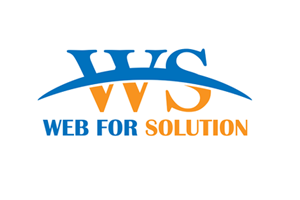Best Software Development Company in Bangladesh
Web For Solution Ltd is one of the best software development company in Bangladesh. play a pivotal role in today’s digital age, driving innovation and efficiency across various sectors. They engage in a wide range of activities that encompass the entire software development lifecycle, ensuring the delivery of high-quality, robust, and scalable software solutions. This comprehensive overview explores the activities of a top-tier software development company, divided into key sections for clarity.
1. Market Research and Requirement Analysis
1.1 Market Research:
Trend Analysis: Keeping abreast of the latest technological trends and market demands.
Competitor Analysis: Studying competitors to identify gaps and opportunities.
Customer Insights: Gathering feedback from potential and existing customers to understand their needs and pain points.

Cases






SKILLS & LANGUAGE
Languages
 English:Advanced
English:Advanced Spanish:Advanced
Spanish:Advanced French:Basic
French:Basic
WHO WE ARE
Amazing HR and Payroll!
Our Hr and Payroll Management software is totally web-based which helps you to operate from anywhere in the world. To keep your business track all the time to save time and money! Our online base HR and Payroll system is totally paperless and very much fast to enhance your business growth instantly. Our dedicated software specialist full fill your exact requirements at a glance!

We help to grow your online business because everyone want to see the quality website with user friendly structure all the way..

High-quality mobile apps on this platform!
WEB ANALYSIS & REQUIREMENTS
First we need to know the core objective of your website like- business goals, target audiences, your preferences etc. For this we will discuss with you several questions that will help to build an effective website.
WEBSITE MOCKUP DESIGN
All the related content, such as images, photos, and videos is created at this step. The customer and target audience must be kept in our mind while we work on a design. The main function of the phase is to represent the structured information, content visualization, and basic functionality demonstration.
PSD TO HTML WEB DESIGN
After getting final approval from you we will start converting our design into the complete shape. We start functional work like- set up CMS, build page templates and theme, install and configure plug-in and customize back-end in this stage.
WEBSITE CONTENT MANAGEMENT
To make sure that the presentation of the web is useful and coherent with its terms we will investigate the relevance of syntax and HTML practices. By following Google Search Engine Optimization Guideline we will check the entire browser supporting system.
IMAGE OPTIMIZATION
Firstly, visual content can get engagement, boost clicks and revenue, and make the page feel more eye-catching. We must underline, considering images details is essential. It means that images size can slow down your website. We use tools for compressing photos without losing its quality. We keep focusing on the visual design which is an approach to convey and speak to the visitors to the progress of the website.
WEBSITE DESIGN FROM CODE LEVEL
Well-designed websites offer much more than just an artistic look. They attract visitors and help people understand the product, company, and branding through a variety of indicators, encompassing visuals, text, and interactions. That means every element of your site needs to work towards a defined goal. This is the stage where we will need to manage all these points.
WEB DESIGN READY FOR APPROVAL
Once you make sure the final mockup design then we will let you know it’s almost ready to run. You can share your required changes if needed.
WEB DESIGN TESTING
We will test the process of technical execution if there is any need for verification tools to fulfill.
ON PAGE OPTIMIZATION
By implementing SEO you can filter the result by location, search groups, or whatever segments you want. We follow the latest SEO on-page technique which is very important to build your brand value shortly.
FINAL OVSERVATIONS
Once we complete building the site we must cross-check all those modules which are families to your specifications. After the placement of your site, we will ensure sufficient continuous performance.

Stakeholder Interviews: Conducting interviews with stakeholders to gather detailed requirements.
Surveys and Questionnaires: Using surveys to collect data from a larger audience.
Workshops: Organizing workshops with clients to define and refine project requirements.
1.3 Feasibility Study:
Technical Feasibility: Assessing whether the project can be developed with the current technology.
Operational Feasibility: Evaluating if the organization can operate the new system effectively.
Economic Feasibility: Estimating the cost-benefit analysis to ensure financial viability.
2. Planning and Project Management
2.1 Project Planning:
Scope Definition: Clearly defining the scope of the project.
Resource Allocation: Assigning resources such as developers, testers, and designers.
Timeline Estimation: Developing a detailed project timeline with milestones.
2.2 Project Management:
Agile Methodology: Implementing Agile practices like Scrum or Kanban for iterative development.
Risk Management: Identifying potential risks and developing mitigation strategies.
Communication Plan: Establishing a communication plan for regular updates and stakeholder engagement.
2.3 Documentation:
Requirement Specification: Creating detailed requirement specification documents.
Technical Documentation: Documenting the technical aspects and architecture of the project.
User Manuals: Developing user manuals and guides for end-users.
3. Software Design
3.1 System Architecture Design:
High-Level Design (HLD): Outlining the overall system architecture, including components and their interactions.
Low-Level Design (LLD): Detailing each component’s design, interfaces, and data flow.
3.2 UI/UX Design:
User Interface Design: Crafting visually appealing and user-friendly interfaces.
User Experience Design: Ensuring a seamless and intuitive user experience through user journey mapping and wireframing.
Prototyping: Creating prototypes to validate design concepts and gather user feedback.
3.3 Database Design:
Schema Definition: Defining the database schema to ensure efficient data storage and retrieval.
Normalization: Normalizing the database to eliminate redundancy.
Database Security: Implementing security measures to protect data integrity and confidentiality.
4. Software Development
4.1 Coding and Implementation:
Programming Languages: Using appropriate programming languages and frameworks based on project requirements.
Code Standards: Following coding standards and best practices to ensure code quality.
Version Control: Utilizing version control systems like Git for efficient code management.
4.2 Integration:
API Integration: Integrating third-party APIs to extend the functionality of the software.
Microservices: Developing microservices for scalable and maintainable architecture.
Continuous Integration (CI): Implementing CI pipelines for automated code integration and testing.
4.3 Customization and Configuration:
Custom Development: Tailoring the software to meet specific client needs.
Configuration Management: Managing configuration files and environment settings for different deployment stages.
5. Quality Assurance and Testing
5.1 Testing Strategies:
Unit Testing: Testing individual components to ensure they function correctly.
Integration Testing: Testing the integration points between components to ensure seamless interaction.
System Testing: Verifying the complete system’s functionality against the requirements.
5.2 Types of Testing:
Functional Testing: Ensuring the software performs all its functions correctly.
Non-Functional Testing: Testing aspects such as performance, security, and usability.
Automated Testing: Using automated tools to execute tests efficiently and repeatedly.
5.3 Bug Tracking and Management:
Bug Tracking Systems: Using tools like JIRA or Bugzilla to track and manage bugs.
Defect Life Cycle: Following a structured defect life cycle from identification to resolution.
Regression Testing: Re-testing the software after bug fixes to ensure no new issues are introduced.
6. Deployment and Maintenance
6.1 Deployment Strategies:
Continuous Deployment (CD): Automating the deployment process for quicker releases.
Staging Environment: Using a staging environment to test the software before production deployment.
Rollback Plan: Having a rollback plan in place in case of deployment failures.
6.2 Post-Deployment Support:
Monitoring: Continuously monitoring the software for performance and issues.
User Training: Providing training sessions and materials to end-users.
Help Desk Support: Offering help desk support for troubleshooting and user assistance.
6.3 Maintenance Activities:
Bug Fixes: Addressing any bugs or issues that arise after deployment.
Updates and Upgrades: Regularly updating the software to include new features and improvements.
Performance Optimization: Continuously optimizing the software for better performance and scalability.
7. Client Engagement and Feedback
7.1 Client Communication:
Regular Updates: Providing regular updates on project progress.
Feedback Mechanism: Implementing a feedback mechanism to gather client input and make necessary adjustments.
Client Meetings: Conducting regular meetings to discuss project status and address any concerns.
7.2 Satisfaction Surveys:
Client Satisfaction Surveys: Conducting surveys to measure client satisfaction and identify areas for improvement.
Net Promoter Score (NPS): Using NPS to gauge client loyalty and likelihood to recommend the company.
7.3 Case Studies and Testimonials:
Case Studies: Developing case studies to showcase successful projects and solutions.
Client Testimonials: Collecting and publishing client testimonials to build credibility and trust.
8. Innovation and Continuous Improvement
8.1 Research and Development (R&D):
New Technologies: Investing in R&D to explore new technologies and tools.
Prototyping: Creating prototypes to test new ideas and concepts.
Innovation Labs: Setting up innovation labs to foster creativity and experimentation.
8.2 Continuous Learning:
Training Programs: Offering training programs to keep the team updated with the latest trends and technologies.
Certifications: Encouraging team members to obtain relevant certifications.
Knowledge Sharing: Promoting knowledge sharing through internal workshops, seminars, and hackathons.
8.3 Process Improvement:
Agile Retrospectives: Conducting retrospectives to reflect on the process and identify areas for improvement.
Lean Practices: Implementing lean practices to eliminate waste and increase efficiency.
Quality Circles: Forming quality circles to involve team members in continuous improvement initiatives.
9. Community Engagement and Corporate Social Responsibility (CSR)
9.1 Community Engagement:
Tech Events: Participating in and sponsoring local and international tech events.
Hackathons: Organizing and participating in hackathons to foster innovation.
Tech Talks: Hosting and attending tech talks to share knowledge and network with industry peers.
9.2 CSR Initiatives:
Education Programs: Supporting education programs and initiatives to promote IT skills development.
Environmental Sustainability: Implementing eco-friendly practices and supporting environmental causes.
Social Causes: Engaging in social causes and community development projects.
10. Global Expansion and Market Penetration
10.1 International Partnerships:
Strategic Alliances: Forming strategic alliances with international firms to expand market reach.
Joint Ventures: Entering joint ventures to tap into new markets and opportunities.
Global Marketing: Developing global marketing strategies to attract international clients.
10.2 Localization:
Local Market Adaptation: Adapting software solutions to meet the specific needs of local markets.
Language Support: Providing multi-language support for global clients.
Cultural Sensitivity: Ensuring cultural sensitivity in software design and marketing strategies.
10.3 Compliance and Standards:
Regulatory Compliance: Ensuring compliance with local and international regulations.
Industry Standards: Adhering to industry standards and best practices to ensure quality and reliability.
Conclusion
The activities of a top-tier software development company encompass a wide range of processes, from initial market research and requirement analysis to deployment, maintenance, and continuous improvement. By excelling in these areas, such companies not only deliver high-quality software solutions but also contribute significantly to the technological advancement and digital transformation of their clients and the broader community

